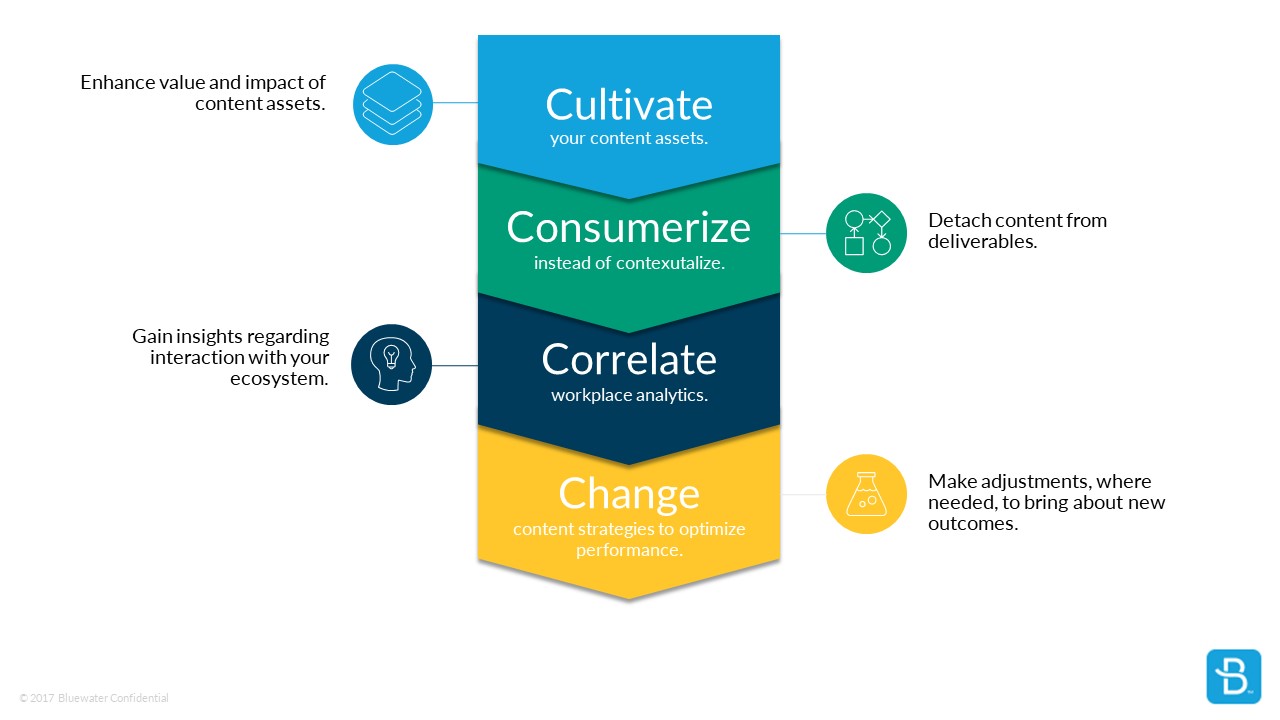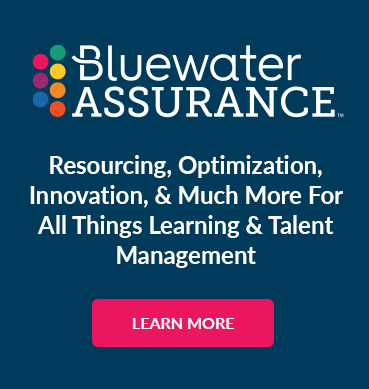Are You Developing Learning or Developing People?
by Chris Bond | November 30, 2017 05:40 AM | The Future of Learning

What’s in a Word?
Lately, I’ve been very interested in the words and metaphors that we use to represent learning in organizations. After all, words have power. They are a primary tool that we use to shape, define, and focus our experiences. Words like “assign”, “comply”, and “track” come to mind when I ponder some of the ones I have heard most frequently around learning. All very practical words, but very focused on the business of “doing learning” and not at all focused on the workforce or the essence of engaging, empowering, and transforming people.
All the while, the organizational landscape is more dynamic than ever before. Today’s most successful corporations are remarkably innovative and agile. They must pivot quickly and efficiently to retain their competitive edge. At the heart of their ability to pivot is their capability to tap into and expand their existing people resources to meet the new market demands.
This is all very important to me because Bluewater focuses solidly on people. In fact, our organizational mission is to “Develop People, Further Business, Transform the World.” We take this mission very seriously and it plays wholeheartedly into our approach to learning experiences and content. In fact, we strive every day to ensure that we are forming and sustaining enduring connections between people, information, technology, and learning in ways that truly propel people forward.
From Catalogues to Galleries
I believe that the changing landscape drastically impacts our role as learning professionals, as it demands that we think and act in new ways. We must shift our focus from the past to the present realities. Gone are the days of spending a great deal of time and minutia creating a perfectly-packaged and all-inclusive learning “event” that is carefully prescribed and assigned to specific individuals. The reality is that by the time we’ve gone through the careful analysis, design, development, and deployment of these learning assets, the business has already shifted. What we are left with are fixed-in-time events that no longer resonate with the organization or the people within it. Furthermore, there’s no additional time or funding left to adapt them – so they become old, stale, and forgotten.
We cannot continue to work tirelessly to create and/or buy voluminous catalogs of increasingly aging and monolithic courses that are collecting dust and/or only being accessed begrudgingly once they are “assigned.” Instead, we must turn our attention to creating galleries of significant, immediate, and relevant learning experiences that users can easily find at their time of need. No longer can “learning” be this activity that requires people to stop what they are doing and “learn.”
Today, learning must be a natural extension of what users already do each day and it should seamlessly adapt to meet their changing needs.
A People-Focused Content Strategy
Put People First
It’s not enough to surface learning experiences in a different manner and then just walk away. We must also carefully design strategies that reach people at the right time along their journey and then monitor them over time to determine their effectiveness. We also need to be ready to adjust the strategies along the way based on what we see. Remember, it’s not about the learning experiences themselves. It’s about the people that are experiencing them and meeting their evolving needs and interests over time.
At Bluewater, we partner with our clients to focus on the business itself and the people within it. This allows us to devise a content strategy that produces real results. It produces results by staying focused on shaping and influencing behavior, as well as allowing for optimal growth and development. It’s so important as learning professionals that we begin with the end in mind and let the needs of actual people drive our work.
We ask important questions like:
- Who are we trying to reach?
- What are we trying to influence?
- How will we know we have moved the needle?
- How will this impact people (and the business) as a whole?
Focus on the 4 Cs of Content Strategy
Only after asking the important questions can we turn our attention from people and start to look critically at learning objects. At Bluewater, we approach this with clients by working through our 4 Cs of content strategy:
1. Cultivate content assets
First, we inventory and evaluate the learning content and experiences that currently exist. We cultivate them into an articulated strategy that provides a personalized and engaging experience for learners at their point of need. Once we have a fresh look at our current offerings and reflect upon the concept of a gallery versus a catalog, we find that some content and experiences should be pushed to the forefront and some might stay in the foreground. Still, other content might no longer be relevant or need to be retired and/or rotated out for a time
2. “Consumerize” instead of contextualizing
When we’ve got a handle on the assets that are available, we can focus on surfacing them and making them accessible to the right people, at the right time and in the right place. While we may not know in advance exactly when or where people might want or need the assets, the goal is to make them flexible, agile, and able to be deployed or “served up” in a variety of formats and situations. This typically means “unlocking” content that may be buried deep within larger courses and “freeing” it to be easily accessible and exchanged as valuable “knowledge currency” amongst a community of users.
3. Correlate learner experience data with business outcomes
After content and experiences are made accessible to learners at their point of need, we can focus on analyzing the learner experience data (xAPI). We correlate the data with information from learner feedback, focus groups, net promoter scores, and business KPIs to evaluate the efficacy of our initial content strategy and articulate the impact of our efforts to the key stakeholders.
4. Change content strategies to optimize workplace performance
Of course, we always recognize that what works today may not work forever. We establish firm baselines and targets and monitor them at regular intervals to ensure that we are flagged when something needs to adapt or change in our existing strategy to better serve our learners.
Typically, we closely monitor the following aspects of our strategy to ensure that we’re on track. Because we’ve gone through the process of optimizing our content to be flexible and adaptive, strategies are easily modified, and content and experiences can be efficiently re-deployed with minimal additional effort:
- Outcomes – Did we move the needle? How did it impact the business?
- Audience – Are we reaching the right people?
- Content – Are we providing the right content?
- Experience – Are we providing the right type of experience?
- Accessibility – Are we deploying to the right places? Is it easy for our audience to find/consume?
- Timing – Are we deploying at the right time?
- Support – Are we aligning to and/or creating the correct long-term support mechanisms to ensure success?
In Conclusion
All in all, this is truly one of the most exciting times ever to be a learning professional. We have an unprecedented ability to make more impact in the lives of the people that we serve than we’ve ever had before. I personally am excited about the road ahead, as we shift our focus to the creation and maintenance of vibrant learning and content strategies and ecosystems that empower people to be their best. I hope you’re as excited as I am about this journey that we’re on together in the learning space. We’re reaching for new heights that will transform our world and place “learners” before “learning”, where they have always truly belonged.
Learn more about developing content with Bluewater's Custom Content services or contact us today to discuss solutions.
Search Our Blogs
Categories
- Ad Hoc (1)
- ADMIN (1)
- administration (1)
- AI (2)
- analytics (2)
- anxiety (1)
- Artificial intelligence (2)
- automation (1)
- BI (1)
- blog (1)
- Blueprint (1)
- center of excellence (10)
- Communication (2)
- COVID-19 (2)
- Culture (1)
- Custom Content (1)
- customer service (1)
- Data (1)
- Employee Engagement (1)
- Shark Bites - Cornerstone Edition (12)
- Shark Bites - SumTotal Edition (4)
- Shark Bites - Ultimate Edition (5)
- The Future of Learning (16)
- The Future of Talent Management (30)
- User Experience (2)
- UX (2)
- wellbeing (1)
Recent Posts
- Selecting Learning & Talent Technology - Part 5: Evaluating Vendors and Solutions
- Selecting Learning & Talent Technology - Part 4: Defining Technology Requirements
- Selecting Learning & Talent Technology - Part 3: Assessing and Aligning Talent Needs
- Selecting Learning & Talent Technology - Part 2: Understanding Business Drivers
- Selecting Learning & Talent Technology: A Strategic Approach to Success



